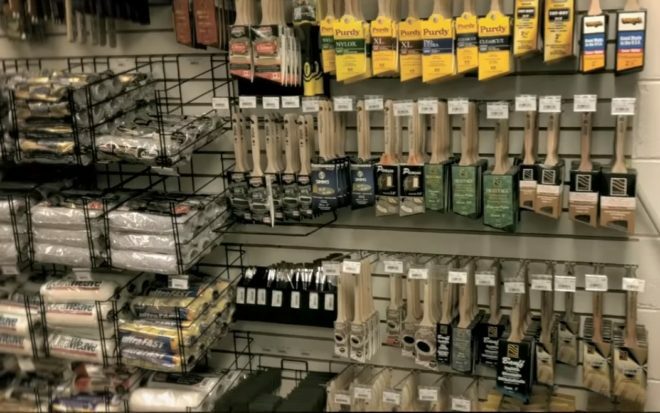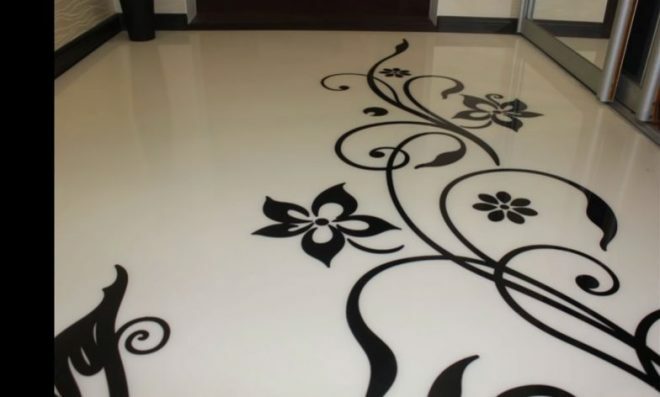- How to choose the right coating
- We go to the store - how not to make a mistake in choosing
- Choose a design - beautiful and non-mark
- Preparing for laying ceramic granite - what you need for work, leveling the base
- How to put ceramic granite on the floor with your own hands
What is the difference between ceramic granite and ceramic tiles? These two materials are similar to each other externally, in composition and in performance characteristics, but because of different production technologies they have significant differences. Unlike tiles, porcelain stoneware has no porosity, internal voids and microcracks, which provides it with much higher strength, water and wear resistance. In addition, he is not afraid of exposure to household chemicals, alkali, acids, or temperature changes. It is because of these qualities that ceramic granite for the kitchen is more suitable than any other material, including stone and traditional tiles.
The hardness of ceramic granite tiles exceeds even natural granite, since it has 8-9 points on the MEP scale, for comparison: granite - only 6 units, and corundum - 10 units.
The porcelain is made from a special mixture of kaolin clays with the addition of mineral pigments, quartz powder, metallic oxides as colorants. It is called ceramic because it necessarily passes the stage of high-temperature firing, combined with pressing.
But even this seemingly ideal material has some drawbacks:
.- The price of outdoor porcelain tiles ranges from 250 to 1800 rubles per square meter. m., and the minimum cost for packing is 500 rubles. Tile in this sense wins;
- Despite the high strength, porcelain stoneware can crack from a very strong blow;
- This floor will be colder than linoleum, laminate or parquet. Therefore it is better to insulate the floor. Otherwise - just lay in the dining area a non-rug carpet;
- There are fewer design options than ceramic tiles.
How to distinguish porcelain tiles from ordinary tiles? It's very simple to do, just look at the cut - at the ceramic granite tile the pigment is painted to the full depth, since it is added at the very beginning of production.
See also: Everything about ceramic tiles for the kitchen floor.
How to choose the right coating
Choosing porcelain stoneware on the kitchen floor, you need to pay attention to the technical characteristics of the coating - wear resistance, geometric dimensions, strength.
It is necessary to know that porcelain stoneware is classified into five groups, depending on the class of abrasion:
- PEI 1 and PEI 2 - only for rooms with low traffic;
- PEI 3 - for residential premises with medium load on the floor;
- PEI 4 - for public buildings with high traffic;
- PEI 5 - rooms with increased traffic, including vehicles: warehouses and others.
Suitable floor tiles for finishing the floor in the kitchen - class PEI 3.
We go to the store - how not to make a mistake in choosing
When you come to the store for floor tiles from porcelain stoneware, arm yourself with a pen and a notebook, to which you write:
- Prices;
- Formats (required, as this is very important for calculating the required amount of material);
- Names of brands and manufacturers;
- Names of collections.
It is better not to buy the version you like at once. Go back home, think it over, and calculate the right amount of tiles with a 10% stock and taking into account the format. Think about what accessories you will need - grout, skirting boards, corners, thresholds. If you want to save money, look for tiles in other stores and online stores by article or simply by name of the brand, collection, etc.
Choose a design - beautiful and non-mark
It should also be borne in mind that porcelain tiles are presented in a variety of design solutions. Here, the appropriate option should be chosen taking into account the general style of the room. Among the traditional design options are:
- "Salt / pepper" - shallow texture on a monochrome background. The most budgetary option;
- Imitation of natural granite, marble (marble-shaped) and other natural stones;
- Textured floor tiles with a complex pattern imitating wood, or with complex abstract patterns;
Porcelain stoneware under the tree for the kitchen is chosen in order for the floor to appear traditional massive, but at the same time it was practical. And this is a very reasonable decision, because today you can find a very naturalistic, wood-like tile. In addition, such a floor will be organically combined with a laminate or a parquet board in other rooms and a hallway.
- Monocolor, monochrome surfaces, painted with natural dyes, and therefore costly;
Using monochrome tiles in different colors, you can lay out the picture on the floor, as shown in the photo below.
In addition, granite can also vary in texture. Thus, a natural (matt) coating is not subjected to post-firing treatment, so that it has increased wear resistance. And when the glazed floor tile is made, the matte surface of the ceramic granite is cut and brightened in a special way.
- On rough, textured surfaces it is impossible to slip, but they are more difficult to wash. On the other hand, dirt on such a floor will be less noticeable;
- Polished surfaces are afraid of scratches, so it's better to put the stubs on the kitchen furniture.
Porcelain tiles for the floor are not much inferior to ceramic tiles according to the variation of the standard sizes. The most popular formats are 30x30 cm, 40x40 cm and 60x60 cm. But you can choose as very large tiles (120x80 cm), and very small (5x5 cm).
Preparing for laying ceramic granite - what you need for work, leveling the base
The installation of ceramic granite by its own hands provides for preparation. At this stage, calculate the required number of tiles, glue, grout. To the amount of tile, obtained in accordance with the area of the premises, add 8-12% for trimming and other errors.
Ceramic granite can be stacked in a seamless way, but this requires a rectified material, with an ideal geometry and very expensive.
The instrument and consumables are prepared:
- Ruler and measuring tape for measuring;
- Building level;
- Spatulas - rubber, notched, metal;
- Marker;
- Nozzle-mixer for the drill;
- A container suitable for preparing a glutinous solution;
- Bulgarian with diamond circles for cutting;
- Crosses, which allow obtaining uniform joints between the tiles;
- Primer for substrate;
- Adhesive mixture;
- Grout;
- Silicone sealant.
The floor tile itself, too, may need preparation - sometimes the material comes with a protective wax or paraffin coating. Wax can be removed with a soap solution, and the paraffin is scraped off with a spatula.
Mandatory preparation of the basis for laying, because significant differences in height can not be eliminated glue mixture. Substandard concrete floor level with bulk mixes. New screed after drying, ground, then cleaned.
The surface must be dry and clean before installing the ceramic granite.
See material on the topic: How to lay a tile with your own hands.
How to put ceramic granite on the floor with your own hands
So, how to put ceramic granite correctly. Specialists recommend that the packing be done by preliminary marking.
It is necessary to find the optimal starting point - from the middle of the room, and the axis line should correspond to the center of the first tile series. If, with this arrangement, the narrow pieces remain on the wall, then it is necessary to change the layout, "pull out" the pruning to where it will not be visible.
Before the floor tiles are laid, it is necessary to check the adhesion of the adhesive to the substrate. Good adhesion will not allow you to immediately separate the glued element.
Adhesive solution is prepared with special care - it does not allow lumps, and the consistency should correspond to thick sour cream.
A metal spatula is used to apply glue to the tile, and then the excess of the solution is removed with a notched trowel. It is important that the adhesive is applied evenly.
And in order for the floor tiles to fit with the same gaps, use special crosses made of plastic. After the installation of the coating is completed, the seams are thoroughly cleaned from excess solutions. To do this, use a wet clean rag.
Keep in mind that once the glue has solidified, cleaning the tile will become much more difficult.
. Loading...
Read also:
- . Sex is known in comparison: we choose a floor covering for the kitchen.
- . The floor is in the kitchen.
- . Cork flooring - 99% ideal floor covering for the kitchen.
- . Parquet board in the kitchen - all the pros and cons.
- . All about linoleum for the kitchen - we compare, choose and steal with our own hands.
- . All about laminate flooring in the kitchen - from choice to installation.


